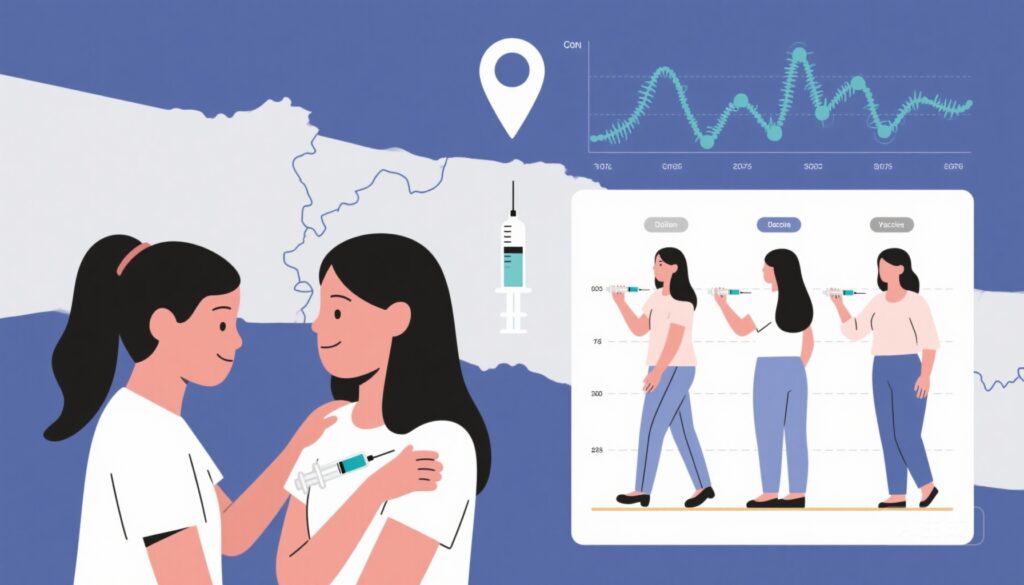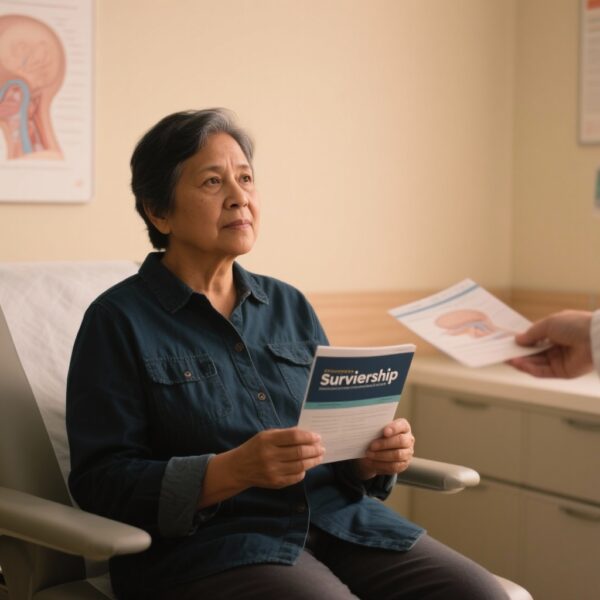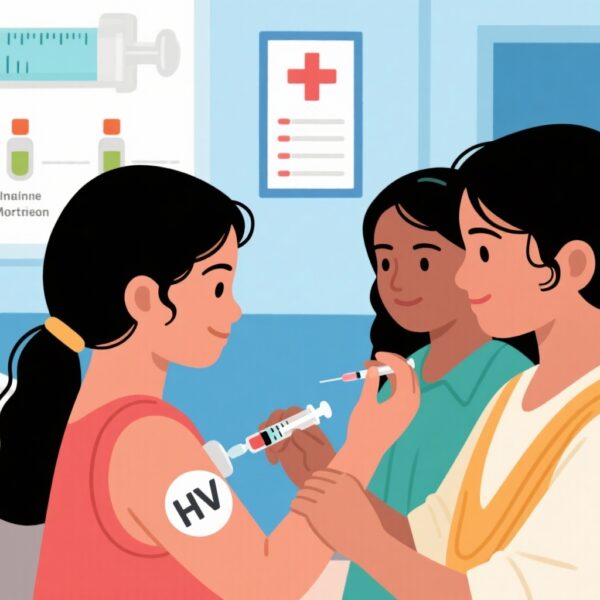Title
Single-dose bivalent HPV vaccine (Cervarix) yields high seropositivity but fails non-inferiority for HPV-16 antibody concentrations versus three-dose quadrivalent regimen
Highlights
- At 36 months, almost 100% of girls (9–14 years) given one dose of AS04-adjuvanted bivalent vaccine were seropositive for HPV-16 and HPV-18.
- Geometric mean concentrations (GMCs) for HPV-18 after one Cervarix dose were non-inferior to three-dose Gardasil-4 in women 18–25 years; HPV-16 GMCs were approximately half and did not meet non-inferiority.
- High seropositivity with lower HPV-16 GMCs highlights limits of immunobridging across vaccines, age groups and doses; clinical protection data against persistent infection remain necessary for regulatory change.
Background and clinical context
Human papillomavirus (HPV) types 16 and 18 cause the majority of cervical cancers worldwide. Prophylactic HPV vaccination is a cornerstone of primary prevention. Historically, regulatory licensing and efficacy demonstration relied on multi-dose schedules (2–3 doses depending on age and product). In 2022 the World Health Organization (WHO) recommended single-dose HPV vaccination as an alternative schedule to expand programmatic reach where full-course coverage is limited. That policy change was driven by accumulating immunogenicity and observational effectiveness data suggesting sustained protection after one dose for some vaccine products and populations.
Regulators, however, generally require evidence that immunologic responses elicited by a candidate schedule are comparable to those from a vaccine/dose regimen with demonstrated efficacy. Immunobridging trials compare antibody responses (e.g., geometric mean concentrations, seropositivity) between a new regimen and an established, efficacious regimen. The PRIMAVERA trial (Lancet Infect Dis 2025) addresses an important regulatory question: is a single dose of the AS04-adjuvanted bivalent HPV vaccine (Cervarix, GSK) administered to girls aged 9–14 years immunologically non-inferior to three doses of the quadrivalent HPV vaccine (Gardasil-4, Merck) in women aged 18–25 years — a combination already demonstrated to be efficacious against persistent HPV infection and cervical disease?
Study design and methods
PRIMAVERA was a non-randomised, open-label, immunobridging, non-inferiority trial conducted in Guanacaste Province, Costa Rica. The trial enrolled 620 girls aged 9–14 years who received a single dose of the bivalent AS04-adjuvanted vaccine and 620 women aged 18–25 years who received three doses of the quadrivalent vaccine at 0, 2, and 6 months.
Primary endpoint
The primary outcome was geometric mean concentrations (GMCs) of serum antibodies specific to HPV-16 and HPV-18 measured by a validated virus-like-particle-based ELISA at 36 months after enrollment.
Key design and analysis features
– Per-protocol cohorts included participants seronegative at baseline for the evaluated HPV type, who received the allocated doses per schedule within predefined windows, had blood at 36 months, and had no additional HPV vaccinations.
– Non-inferiority criterion: lower bound of the 96% confidence interval (CI) for the GMC ratio (single-dose bivalent group ÷ three-dose quadrivalent group) ≥ 0.67 for each HPV type.
– Seropositivity at 36 months was a secondary endpoint.
– Safety was assessed in all vaccinated participants.
The trial was registered (ClinicalTrials.gov NCT03728881) and funded by the U.S. National Cancer Institute, Cancer Research UK, and the Bill & Melinda Gates Foundation.
Key findings
Enrollment and per-protocol numbers
– 620 girls and 620 women were enrolled and received at least one vaccine dose. After exclusions for baseline seropositivity or protocol deviations, the per-protocol cohorts comprised 539 girls and 366 women for HPV-16 analyses, and 523 girls and 373 women for HPV-18 analyses.
Antibody concentrations at 36 months
– HPV-16: GMC in single-dose bivalent (girls) = 21.4 IU/mL (95% CI 19.7–23.3). GMC in three-dose quadrivalent (women) = 42.9 IU/mL (95% CI 38.9–47.3). GMC ratio = 0.50 (96% CI 0.44–0.57). The lower bound (0.44) is below the 0.67 non-inferiority margin; therefore non-inferiority was not demonstrated for HPV-16.
– HPV-18: GMC in single-dose bivalent = 8.0 IU/mL (95% CI 7.4–8.8). GMC in three-dose quadrivalent = 7.2 IU/mL (95% CI 6.4–8.1). GMC ratio = 1.11 (96% CI 0.95–1.29), meeting the non-inferiority criterion for HPV-18.
Seropositivity at 36 months
– HPV-16 seropositivity: 538/539 girls (99.8%, 95% CI 99.1–100) vs 366/366 women (100%, 99.2–100); p=1.00.
– HPV-18 seropositivity: 517/523 girls (98.9%, 95% CI 97.6–99.5) vs 358/373 women (96.0%, 95% CI 93.6–97.6); p=0.0065. The single-dose group had a statistically higher seropositivity proportion for HPV-18.
Safety
– Serious adverse events (SAEs) were uncommon and judged unrelated to vaccination: 2 SAEs among 620 girls and 13 SAEs among 620 women; no vaccine-related serious adverse events were reported.
Interpretation and clinical significance
Immunobridging outcomes
PRIMAVERA found that a single dose of Cervarix administered to 9–14-year-old girls produced robust antibody responses and near-universal seropositivity for both HPV-16 and HPV-18 at 36 months. However, the trial did not meet the pre-specified non-inferiority criterion for HPV-16 GMCs versus the three-dose Gardasil-4 reference group. HPV-18 GMCs were non-inferior and seropositivity was slightly higher in the single-dose bivalent group.
Biological and methodological considerations
– Age and immune responsiveness: Younger adolescents typically mount higher immune responses to HPV vaccines than older women; comparing 9–14-year-old girls to 18–25-year-old women may bias toward non-inferiority. Despite that, HPV-16 GMCs were lower in the single-dose Cervarix group.
– Vaccine composition and adjuvant: Cervarix (AS04-adjuvanted bivalent) and Gardasil-4 (aluminum-adjuvanted quadrivalent) differ in antigen content and adjuvants. Cross-product immunobridging assumes that antibody concentrations elicited by one product can be interpreted versus another product with proven efficacy; this is complex and imperfect. Notably, Cervarix has previously shown high antibody titers and durable responses in other settings.
– Assay comparability: PRIMAVERA used a validated virus-like-particle-based ELISA with international units, which facilitates comparisons across studies, but assay variability still requires cautious interpretation.
– Correlates of protection: No definitive quantitative correlate of protection for HPV exists. Trials and post-licensure data suggest that high seropositivity and sustained antibody levels correlate with protection against persistent infection; however, absolute antibody thresholds for protection are not established for HPV-16/18. Therefore, failure to meet a non-inferiority margin for GMC does not necessarily equate to lack of clinical protection.
Regulatory and policy implications
PRIMAVERA provides valuable immunogenicity evidence but, by failing to demonstrate non-inferiority for HPV-16 GMCs, it is unlikely by itself to support regulatory approval of a single-dose indication for Cervarix. Regulators typically require either direct evidence of efficacy against persistent infection/disease or robust immunobridging to a licensed and efficacious regimen. Because HPV-16 is the dominant oncogenic type, reduced GMCs for HPV-16 raise reasonable regulatory caution.
Programmatic considerations
From a public health perspective, a single-dose schedule that reliably prevents persistent HPV infection would be transformational, especially in low-resource settings where series completion is limited. PRIMAVERA strengthens the evidence that single-dose Cervarix produces sustained seropositivity; however, definitive recommendations should await direct protection data or converging immunobridging results across vaccine products and age groups.
Strengths and limitations
Strengths
– Large sample size with long (36-month) follow-up and near-complete serological data in the per-protocol populations.
– Use of an international-unit-standardized ELISA and prespecified non-inferiority margins.
– Inclusion of an age-appropriate adolescent cohort for the single-dose strategy, reflecting real-world target populations.
Limitations
– Non-randomised, open-label design with different age groups and distinct vaccine products limits causal inference and complicates direct comparisons.
– Immunobridging compares immunogenicity rather than clinical endpoints (i.e., persistent infection or high-grade cervical disease). Without a validated correlate of protection, antibody GMCs are a surrogate imperfectly linked to efficacy.
– The comparator regimen (three-dose Gardasil-4 in 18–25-year-old women) reflects a historically efficacious combination, but differences between products (bivalent vs quadrivalent) and adjuvants may influence antibody kinetics.
Expert commentary and context
WHO’s 2022 recommendation to accept single-dose schedules in certain contexts reflects a balance between pragmatic program goals and evolving evidence. PRIMAVERA contributes an important, product-specific dataset for Cervarix, showing sustained seropositivity but mixed results by antigen. The data underscore the need for direct effectiveness trials measuring incident and persistent infection (HPV DNA) and clinical endpoints to inform regulatory decisions. Several randomized and observational studies assessing single-dose effectiveness are ongoing or recently reported; regulatory decisions will rest on the totality of evidence across immunogenicity, clinical endpoints, and real-world programmatic impact.
Conclusions and next steps
PRIMAVERA demonstrates that a single dose of the AS04-adjuvanted bivalent HPV vaccine elicits durable seropositivity for HPV-16 and HPV-18 at 36 months in girls aged 9–14 years and meets non-inferiority for HPV-18 antibody concentrations relative to three-dose Gardasil-4 in women aged 18–25 years. However, the trial did not meet non-inferiority for HPV-16 GMCs. These results strengthen the immunologic rationale for single-dose use but are insufficient alone to prompt regulatory approval for a single-dose Cervarix indication.
Regulatory and policy bodies should consider: direct vaccine efficacy data for single-dose regimens where available, pooled immunogenicity evidence across products and populations, and programmatic benefits versus potential marginal decreases in type-specific antibody concentrations. Ongoing and future randomized trials or well-conducted observational effectiveness studies measuring persistent infection will be decisive for establishing the protective efficacy of single-dose HPV vaccination.
Funding and clinicaltrials.gov
Funders: U.S. National Cancer Institute, Cancer Research UK, Bill & Melinda Gates Foundation.
ClinicalTrials.gov identifier: NCT03728881.
References
1. Cortés B, Ocampo R, Porras C, et al. Human papillomavirus (HPV) type 16 and type 18 antibody concentrations after a single dose of bivalent HPV vaccine in girls aged 9-14 years compared with three doses of quadrivalent HPV vaccine in women aged 18-25 years in Costa Rica (PRIMAVERA): a non-randomised, open-label, immunobridging, non-inferiority trial. Lancet Infect Dis. 2025;25(12):1314–1324. doi:10.1016/S1473-3099(25)00284-1.
2. World Health Organization. SAGE report and recommendations on HPV vaccination (2022). WHO position statements and SAGE recommendations on immunization (2022). [Available from WHO website]



